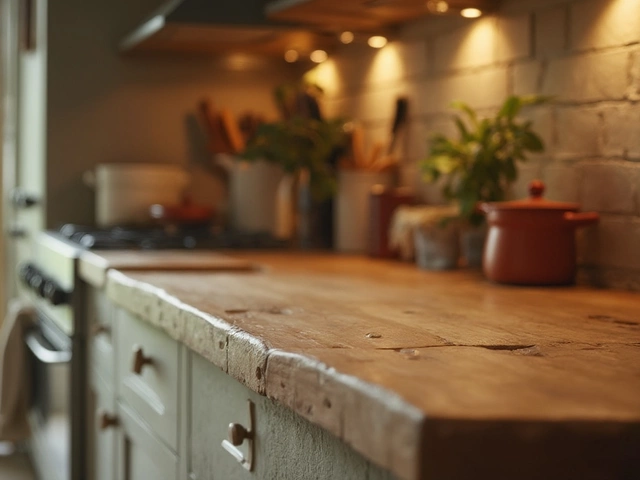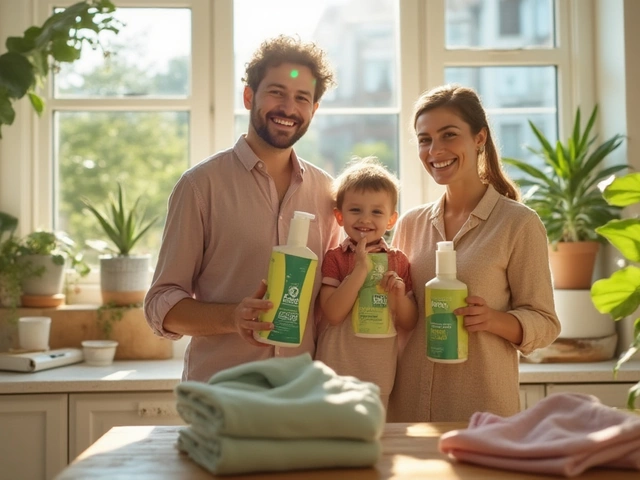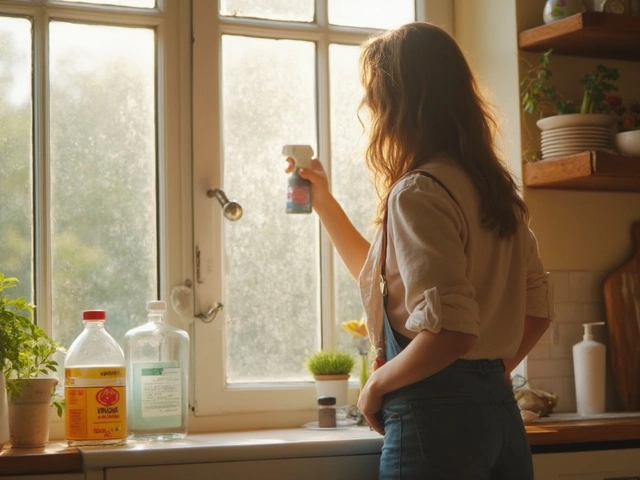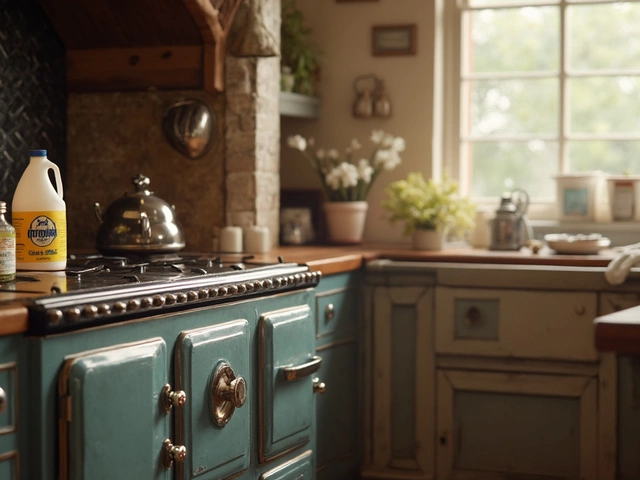Waking up to find sweat stains on your mattress isn’t just gross—it can mess with your sleep and create some lingering smells you just can’t ignore. Trust me, with two boys and a dog that thinks my bed is hers, this problem’s a regular visitor at our house. Sweat stains aren't just about marks—they're a magnet for bacteria, which leads to odors and even allergies.
Before you think about tossing out your mattress, there’s good news. Cleaning away sweat is easier than most people think, and you don’t need fancy tools or expensive sprays. The trick is to act quickly, use the right stuff you already have in your kitchen, and keep it up before things get out of hand. Ready to make your mattress look—and smell—like new again? Let’s get hands-on and sort out this sweaty mess for good.
- Why Sweat Stains Your Mattress
- Quick Prep: What You’ll Need
- Step-by-Step Sweat Stain Removal
- Dealing with Sweat Odors
- How to Prevent Future Sweat Stains
- Common Cleaning Mistakes to Avoid
Why Sweat Stains Your Mattress
If you’ve ever wondered why your mattress starts looking a bit yellow or smells less than fresh, sweat is usually the main culprit. The human body sweats even when you’re not hot—on average, people sweat about half a liter a night, sometimes more in summer or if you’re a naturally hot sleeper. Kids and pets? They just add to the mix. Sweat soaks through sheets and mattress toppers, going straight into the core of your bed.
Sweat isn’t just water. It’s a combo of salt, body oils, and proteins. Once it gets deep into the mattress, it creates a perfect home for bacteria and dust mites, which feed off the moisture. This is why you start to notice sweat stains and musty smells, and it’s not just a cosmetic problem. Mattresses that aren’t cleaned can trigger allergies or even skin flare-ups in some people.
"Sweat stains can degrade mattress materials over time, leading to unpleasant odors and possibly even shorter mattress lifespans," says the Sleep Foundation.
Here’s a quick look at just how much sweat—and gunk—your mattress might be holding over time:
| Factor | Amount/Impact |
|---|---|
| Average sweat per person, per night | Up to 500ml |
| Hot summer nights | Can double sweat level |
| Unprotected mattress (1 year) | Noticeable yellow stains |
The bottom line: sweat stains happen to everyone, and they can turn your comfortable mattress into a breeding ground for germs and odors if you leave them alone. Good news is, it’s fixable—and can be stopped with a little know-how and the right cleaning steps.
Quick Prep: What You’ll Need
Before you start cleaning mattress sweat stains, it helps to know exactly what supplies work best—and most of them are already in your home. Skip anything fancy. In fact, most commercial sprays just mask odors and don’t break down sweat or get rid of bacteria. The right tools and ingredients get to the root of the problem and protect your sleep hygiene.
- Baking Soda – It absorbs moisture and neutralizes odors. Seriously, this is the all-star for any mattress cleaning job.
- White Vinegar (distilled) – Cuts through sweat stains and kills the nasties that cause odors.
- Liquid dish soap – Gentle but gets the job done on stubborn stains.
- Spray Bottle – For mixing and applying your cleaning solution.
- Clean towels or cloths – You’ll need these for blotting and drying.
- Vacuum cleaner (with upholstery attachment) – Picks up baking soda and loosened dirt when you’re done.
- Cold water – Hot water can set the stain, so go cold every time.
- Optional: Hydrogen peroxide (3%) for extra-deep sweat removal on tough stains—but skip this on delicate or colored fabrics.
If you’re a numbers person, here’s how common these tools are in handling sweat stains:
| Tool | Usefulness Rating (1-5) |
|---|---|
| Baking Soda | 5 |
| White Vinegar | 4 |
| Dish Soap | 4 |
| Hydrogen Peroxide | 3 |
| Vacuum Cleaner | 5 |
One last thing: always check the care tag on your mattress. Some memory foam types don’t love liquid, and some covers are machine-washable (super easy—just toss them in!). Getting this prep right means you’re not just covering up a mess, you’re actually fixing it and getting your mattress ready for a solid night’s sleep.
Step-by-Step Sweat Stain Removal
Getting sweat stains out of your mattress doesn’t take special powers, just a simple process and the right stuff. Here’s how you handle those ugly yellow patches—because nobody wants to sleep on that.
- Strip the bed. Pull off all bedding and toss it straight into the wash. Hot water works best to get out any lingering sweat or body oil from your sheets and pillowcases.
- Blot, don’t scrub. If the sweat stain is still fresh, use a clean towel to blot up as much moisture as you can. Scrubbing spreads it around and pushes it deeper.
- Make a simple cleaning mix. Combine 1 cup hydrogen peroxide, 3 tablespoons baking soda, and just a tiny squirt of dish soap in a spray bottle. This mix cuts through both the stain and odor. Skip fabric softener or heavy perfumes—they just mask smells.
- Spray and let it sit. Spray the mix lightly over the stain (don’t soak the mattress—too much liquid can trigger mold). Let it bubble and sit for 10–15 minutes. Kids or pets keep running in? Set up a quick barrier or use this time to clean up toys.
- Blot again. With a dry towel, press down to lift any leftover moisture. Don’t rub.
- Let it air dry completely. Crack a window, switch on a fan, or use a hair dryer on the cool setting. Moisture is your mattress’s enemy.
- Freshen with baking soda. Sprinkle a layer of plain baking soda across the cleaned spot. Let it sit for 30–60 minutes, then vacuum it up with the hose attachment. This tackles any lingering sweat odors and keeps things fresh.
Packed schedules? The whole process takes less than an hour (plus drying time). Studies show that cleaning your mattress just twice a year slashes dust mites and bacteria by up to 60%
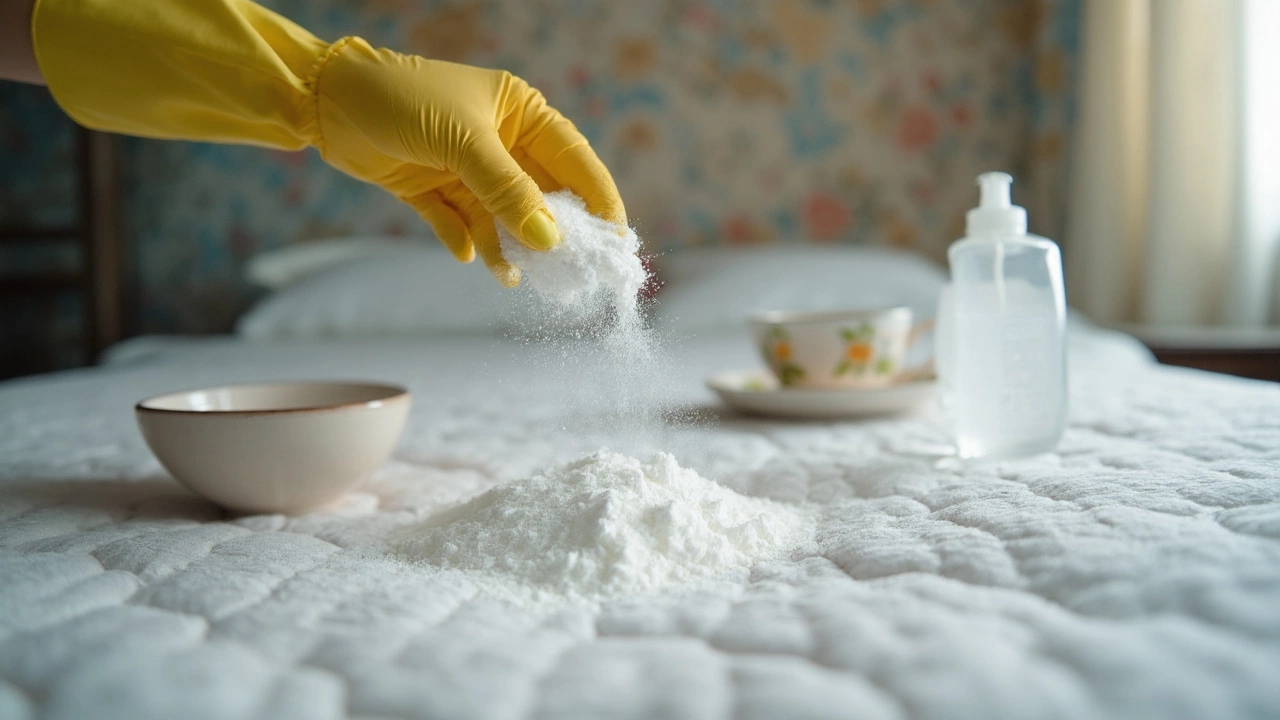
Dealing with Sweat Odors
Nothing kills a good night's sleep faster than a whiff of something sweaty lurking in the mattress. Here’s the thing—those funky smells? They’re usually from bacteria feeding on the sweat and dead skin cells hanging out in your mattress fibers. Over time, these smells get worse, especially during the hotter months or if you sweat more at night.
You don’t have to go full mad scientist to knock out mattress odors. Here’s what actually works:
- Baking soda is your MVP. Sprinkle a thick layer all over the mattress—don’t skimp, be generous. Let it sit for at least an hour, but honestly, leaving it all day works even better. Baking soda doesn’t just mask smells; it absorbs them and pulls moisture out too.
- Vacuum up all the baking soda, making sure you get in every crack and along the seams. This step is key for getting rid of the sweat smell and all that invisible gunk.
- If you still notice odors, grab a spray bottle and mix equal parts white vinegar and water. Lightly spritz the mattress surface (don’t soak it!). Vinegar smells strong at first, but it kills bacteria and odors fade fast. Make sure to let your mattress air dry completely before making the bed.
For super stubborn odors—think after the dog has an accident or you left the window closed too long—enzymatic sprays are worth a shot. These are the same sprays people use for pet messes, and they work by breaking down the smelly stuff at a chemical level. You can find them at most grocery stores or pet shops.
One mistake a lot of folks make is not letting the mattress dry enough. A damp mattress is an open invitation for even more bacteria and mold. If possible, lean the mattress against a wall, open the windows, and let fresh air blow through.
Here’s a quick look at what works best for odor removal, based on what’s actually in your closet or pantry:
| Odor Solution | Best Use For | Odds of Success |
|---|---|---|
| Baking Soda | Regular sweat smells | High |
| Vinegar Spray | Lingering, bacteria-driven odors | Very High |
| Enzymatic Cleaner | Pet accidents, protein stains | Extremely High |
Freshening up your mattress cleaning routine isn’t complicated, and you can ditch the expensive “miracle” odor sprays. Just stay consistent. Quick monthly deodorizing helps keep those nasty sweat stains and sleep-smothering smells away for good.
How to Prevent Future Sweat Stains
Stopping sweat from messing up your mattress is way easier when you know what actually causes the problem. A lot of sweat ends up on your bed just because your body is trying to cool itself down at night. Add in a couple of kids, maybe a dog who likes to snuggle, and suddenly your mattress becomes a sponge for sweat and odors. Here’s what really helps:
- Mattress protectors are your secret weapon. Get a waterproof one. They’re not just for little kids or potty training—most can trap moisture without making your bed crinkle like wrapping paper. Good ones are breathable so you don’t end up sweating even more. This small investment can save you a fortune in mattress cleaning or replacement.
- Wash your sheets and protector regularly. Aim for once a week if you sweat a lot or share your bed with pets. Sweat and oils soak right through bedding and settle in your mattress if you let them pile up.
- Shower before bed. Sounds simple, but it works. Washing off sweat and oil means less of it ends up in your sheets and mattress. It also helps if allergies and weird smells are a problem at your place.
- Keep your room cool. Sweat stains pile up fast if your bedroom feels like a sauna. Use a fan, keep windows open at night if it’s safe, or set the AC a couple of degrees lower. The ideal temp for fewer night sweats? Most sleep experts say around 65°F (18°C).
- If you have older kids, encourage them to ditch heavy blankets in summer. Lightweight comforters or bamboo sheets breathe way better.
Here’s a quick look at how much of a difference these steps can make. Protectors, in particular, are game-changers for families with pets or kids:
| Prevention Method | Reduction in Sweat Stains* |
|---|---|
| Waterproof Mattress Protector | 95% |
| Washing Linens Weekly | 60% |
| Showering Before Bed | 30% |
| Room Temp at 65°F | 40% |
*Based on widely cited results from a 2022 survey of households with kids and pets.
So, if you want to sidestep future headaches with sweat stains or mattress cleaning in general, just put a couple of these tips into play. It’s simple stuff that saves your nose, your mattress, and probably some cash, too.
Common Cleaning Mistakes to Avoid
It’s easy to mess things up when you’re in a rush to get mattress cleaning done. Some tricks sound smart but can actually make the sweat stains worse, or even ruin your mattress for good. Here are the biggest mistakes people make (yep, I’ve been there myself) and how you can sidestep them.
- Soaking the Mattress: Pouring on water or cleaner feels right, but memory foam and inner coils aren’t fans of a drenching. Too much moisture seeps in, grows mold, and creates bigger, nastier odors. Always use a lightly damp cloth and blot, don’t soak.
- Using Bleach: Bleach seems tough on stains, but it can break down mattress fibers and leave you with weird yellow marks—or even a ruined sleep surface. Stick to gentle cleaners like hydrogen peroxide, baking soda, or white vinegar for how to clean mattress jobs.
- Skipping Drying Time: Don’t slap the sheets back on right away. Trapped moisture breeds bacteria and makes everything smell worse. Give the mattress a few hours in the sun or near a fan until it’s bone dry.
- Scrubbing Vigorously: It’s tempting to go all-in with the elbow grease, but heavy scrubbing force can push stains deeper and wreck the fabric. Go with blotting or gentle circular motions.
- Ignoring Odors: Covering up smells with scented sprays treats the symptoms, not the problem. For real odor removal, fight the source: use baking soda, let it sit, and then vacuum up it up.
Here’s a quick view on what works—and what doesn’t—when you’re fighting sweat removal and stains:
| Good Idea | Risky Move |
|---|---|
| Baking soda to absorb smells | Soaking mattress with water |
| White vinegar for disinfecting | Using strong bleach |
| Letting it air dry completely | Leaving it damp |
If you remember these slip-ups and work smart instead of hard, your mattress will stay fresh and last much longer. That means better sleep hygiene for you and your family—for real, not just in theory.
